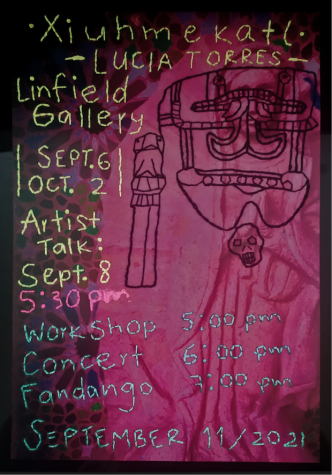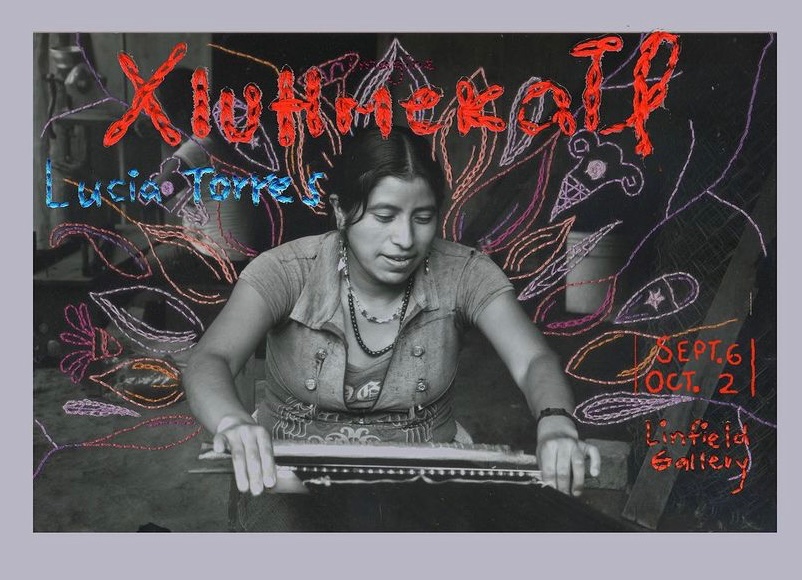Lucia Torres: Art all the way from Mexico
September 24, 2021
“If a man sees you and he recognizes you, suddenly you’re talented, you’re pretty. But, in reality they see you as that because you are that,” Lucia Torres said. “It creates friction within women when we compete for the validation of men.”
Torres is a mixed media artist and musician visiting Linfield’s Miller Fine Arts Center whose art will be showcased until Oct. 2. Torres’ exhibit is titled Xiuhmekatl, which means “interconnected communities by a thread”, and features many styles of art including embroidery, textiles, music and dance. Torres is a native of Mexico City visiting with her band, Semilla, which means “seed.”

As a young girl Torres danced the traditional Mexican dance called Folklorico. She was first inspired to become a musician after being invited to a party in college by her now bandmate, Sergio, where she heard the fandango for the first time. She describes the experience as life changing.
“Sergio and the band invited me to a party and I was wearing my shoes, so I started to zapatear (stomping) there,” Torres said. “I went to rehearse with the band on Friday, and then I never left. I became part of the band.”
After finding her passion, Torres traveled to Veracruz, Mexico, where the fandango originated. Torres said that she felt she had to go to Veracruz to feel the full experience of the fandango and the music. Torres wanted to break down the gender roles and experience all elements of the fandango, even though in Mexican culture, only men play the music.
In Veracruz, Torres found herself falling in love with the culture and with the community of the fandango. She ended up learning all the parts of Fandango. Fandango is a party where people get together to dance, sing, play and connect with the community. The music played at Fandango is Son Jarocho which is played on the Jarana Jarocha, which is a guitar-like string instrument from Mexico.
The main instrument of the fandango is a Tarima, which is a wooden platform where dancers perform the Zapateado on. The Zapateado is a lively two person dance performed on the Tarima, which keeps the beat for the musicians. Torres noted that the tarima is the main instrument of the fandango because the music follows the steps of the dancers.

Torres isn’t just a talented musician, she also excels at multimedia art. Torres’ main medium is textiles, which she creates while in community with other women, who are working on their own textile items as well. Torres emphasizes how being in community with the women while creating is an essential part of her artwork.
The medium that will be seen in the exhibit at Linfield is mainly embroidery. Torres got inspired by the women in the community she makes textiles with, and decided to embroider over photos she took for the exhibit.
Torres creates art with meaning. Every piece examines the community of Mexico. One of the meanings seen in some of her pieces in the exhibition is femicide, which is homicide, specifically women killed due to gender violence. Femicide is a common problem in Mexico, which is part of the reason Torres was inspired.
Torres created the piece “No podrán detener la primavera violeta,” which translates to “You can’t stop the violet spring.” In Mexico, the color violet represents feminism and women empowerment. The violet is part of the “purple revolution” which is a movement of women in Mexico taking back all their power.
Inspired by this piece, she created crocheted flowers with fellow women from the community. She placed the flowers on a bridge in Mexico where many women were assaulted or felt unsafe to bring power back to those women.
Most of Torres’ inspiration for her artwork comes from her community and her friends.
“It has been through the eyes of friends that I have been able to see myself as an artist,” Torres said.
Torres’ exhibit was supposed to be up last year at Linfield, but due to COVID-19 the exhibit was postponed to this year. She has never shown at a college before, and is very excited to show at Linfield. Torres found the beginning of the exhibition organization difficult and she struggled with it, but Torres’ felt it was healing to share art.
Torres mentioned that artists in Mexico struggle with finding a stable job. Especially with the pandemic, many people in Mexico are out of a job. Torres was excited that this exhibition would open more doors for her as an artist because it was her first individual show.
For future artists Torres gives a strong piece of advice: “Bring your own experiences and even if others tell you how to do a certain thing you will do that certain thing how it fits you.”
“Life always brings me back to art,” Torres said.
Torres finds that wherever she is in her life art is always consistent, even if times get tough.
“The work of an artist is difficult and it will have difficult moments, but in the end the reward is on the other side,” Torres said. “Sometimes the reward comes with personal growth, which is reflected on the outside.”
“In my experience, sometimes I have tried to be someone I am not, and I have just been turning in circles, but in the end I flourished to be who I’m meant to be.” Torres said. “So if you feel that in yourself, if you feel that spark of who you are and where you want to take your artistic work then be faithful to what you feel. If you have to give it several turns, then that’s part of becoming who you are.”
The showcase will be in the Linfield Miller Fine Arts Center until October 2.

